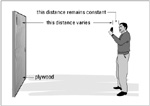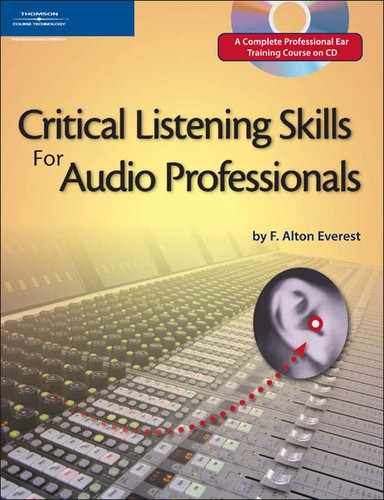| In previous lessons, we have noted the effect on the sound of a voice of peaks and dips in the response of an audio system. In this lesson, we shall concentrate on various acoustical effects which make a voice sound unnatural. |

|
| In recording a voice in a room, there is no escaping the acoustical effect of the surroundings. The sound is contained by the surfaces of the room; and size, shape, and proportions of the room, and the absorbing and reflecting characteristics of the surfaces determine the sound field in the room. For example, my voice is being recorded in an acoustically treated studio with the microphone about six inches from my lips. At such a close distance, the room effects are certainly present but not dominant. Notice carefully the change in character of my voice as the microphone is placed at successively greater distances from me.
The microphone is now in its normal position, about six inches from my lips. |

|
| The microphone is now about three feet from me, but I am still talking in the same tone of voice as before. |

|
| The microphone is now ten feet from me. You will notice a distinct change in voice quality as the distance is increased. |

|
| The microphone is now back to the three-foot distance, as you note carefully the change in voice quality as effected by the distance to the microphone. |

|
| The microphone is now back in its normal position, about six inches from my lips. |

|
| With the microphone close to my lips, the direct sound dominates. The sound reflected from the walls, floor, and ceiling is weaker because it travels farther and some sound energy is lost at each reflection. The greater the microphone distance, the more the room effect dominates. |

|
| Now we shall go to another room, whose surfaces are largely hard and reflective, and repeat the experiment.
This room is untreated acoustically and is very “live.” Even with the microphone at the normal six-inch distance, you can hear that my voice sounds distinctly different from that in the studio. |

|
| The microphone is now three feet from my lips. Notice that the reverberation of the room changes the sound of my voice materially. |

|
| The microphone has now been moved so that it is ten feet from me. The direct sound is lower because of the distance and the reverberant sound is dominant. |

|
| The microphone is now back to the three-foot distance, and you will again note the room effect. |

|
| The microphone is now back at the normal six-inch distance. Although the room effect has decreased at this distance, it is still there. |

|
| These two experiments focus our attention on the importance of room acoustics and microphone distance on recorded voice quality. However, further analysis is impractical because of the overwhelmingly complex nature of the sound field in a room. For this reason, we shall reduce the next experiment to the simple case of a single acoustical reflection from a sheet of plywood. | |
| In this experiment, I will hold the microphone at a constant distance from my lips so that the direct sound will be unchanged.
By walking toward the plywood, the sound reflected from it will increase the closer I get. Here we go!
I am now about ten feet from the plywood sheet and walking slowly toward it, talking continually so that you can detect any changes in the quality of my voice. Now I am about five feet from the plywood and still moving. Note carefully the change in my voice as I move closer to the plywood. Do you hear a changing roughness in my voice as the direct and reflected rays combine? As I now move slowly backward, my voice returns to normal. |

|
| The coloration of my voice while close to the plywood sheet is the result of the sound of my voice traveling directly to the microphone combining with the reflection from the plywood, which is slightly later because of the greater distance traveled. This time delay of the reflected ray is small (of the order of a thousandth of a second) but its influence is great. |

|
| The entire effect can be simulated for easy study by using a delay device. In the following example, a voice signal is combined with the same signal delayed one-half of a thousandth of a second (or one-half millisecond) with respect to the direct sound: |

|
| |

|
| A one-millisecond delay affects the voice this way: |

|
| Increasing the delay to 1½ milliseconds has this effect on the voice: |

|
| We now go back to the reference sound without the delayed reflection:
The effect of a delayed signal is most noticeable as the changes are taking place. The following example is similar to those we have just heard except that the delay varies continually between zero and 1½ milliseconds: |

|
| Voice colorations result any time a sound component is combined with itself delayed a bit. The plywood reflector provided such a delay with a single microphone. A hard table top close to the microphone can do the same thing. |

|
| |

|
| If the same sound strikes two microphones separated at a distance, and the outputs of the two are combined, wild frequency response variations will result. At frequencies at which the two components are in phase, the signals add, giving a 6-dB peak. At frequencies at which they are out of phase, they cancel, resulting in a 30- or 40-dB dip in response. Down through the audible spectrum, these peaks and dips drastically change our normally uniform response, and this is what changes the character of the sound. This is commonly called a comb filter because the frequency response peaks and dips look like a comb when plotted.
Critical evaluation of audio signals requires the ability to detect voice colorations and to form some idea of their cause. Some of the following selections are normal, recorded in a studio with a close microphone. Others are colored by one of the methods we have studied. |


|
| See if you can identify those with colorations and the source of the coloration:
Selection A:
Selection B:
Selection C:
Selection D:
Selection E:
Selection F:
Selection G:
Selection H:
Selection I:
Selection J:
Go back over the material in this lesson until you are familiar with the sound of voice colorations and can give a good estimate as to their probable causes. | Use evaluation sheet to record your identifications:
|






















